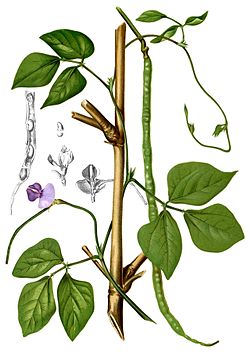| Vigna | |
|---|---|
 | |
| Cowpea (Vigna unguiculata) | |
| Scientific classification | |
| Kingdom: | Plantae |
| Clade: | Tracheophytes |
| Clade: | Angiosperms |
| Clade: | Eudicots |
| Clade: | Rosids |
| Order: | Fabales |
| Family: | Fabaceae |
| Subfamily: | Faboideae |
| Clade: | Millettioids |
| Tribe: | Phaseoleae |
| Subtribe: | Phaseolinae |
| Genus: | Vigna Savi (1824), nom. cons. |
| Subgenera | |
| |
| Synonyms [1] | |
| |
Vigna is a genus of plants in the legume family, Fabaceae, with a pantropical distribution. [2] It includes some well-known cultivated species, including many types of beans. Some members of the genus were previously classified in Phaseolus . According to Hortus Third, Vigna differs from Phaseolus in biochemistry and pollen structure, and in details of the style and stipules.
Contents
- Uses
- Selected species
- Subgenus Ceratotropis
- Subgenus Haydonia
- Subgenus Lasiospron
- Subgenus Vigna
- Incertae sedis
- References
- External links
Vigna is also commonly confused with the genus Dolichos , but the two differ in stigma structure. [3]
Vigna are herbs or occasionally subshrubs. The leaves are pinnate, divided into 3 leaflets. The inflorescence is a raceme of yellow, blue, or purple pea flowers. The fruit is a legume pod of varying shapes containing seeds. [4]
Familiar food species include the adzuki bean (V. angularis), the black gram (V. mungo), the cowpea (V. unguiculata, including the variety known as the black-eyed pea), and the mung bean (V. radiata). Each of these may be used as a whole bean, a bean paste, or as bean sprouts.
The genus is named after Domenico Vigna, a seventeenth-century Italian botanist and director of the Orto botanico di Pisa. [5]

